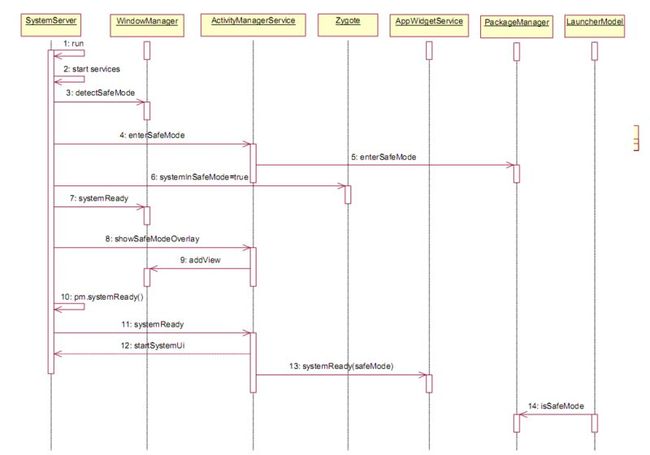A20关机长按关机按钮提示进入安全模式
长按电源键弹出关机按钮,长按关机按钮会弹出进入安全模式的设置,进入安全模式后将停止所有的第三方APP的加载,由于我们的系统只有自己定制的lunch,所以已经去掉系统的加载项LUNCHER2,进入安全模式后无法加载启动项而停在android界面,导致系统无法启动,为了避免系统进入安全模式,只有屏蔽长按关机按钮。
android\frameworks\base\policy\src\com\android\internal\policy\impl\GlobalActions.java
在private GlobalActionsDialog createDialog() 这个方法里定义关机界面和各种模式的选择等操作监听事件;
以下是长按关机按钮弹出安全模式选择的按钮监听:
dialog.getListView().setOnItemLongClickListener(
new AdapterView.OnItemLongClickListener() {
@Override
public boolean onItemLongClick(AdapterView<?> parent, View view, int position,
long id) {
return mAdapter.getItem(position).onLongPress();
}
});
我们要做的就是把它改成
dialog.getListView().setOnItemLongClickListener(null);
即可停止监听长按关机按钮事件,也就表面上阻止了用户选择安全模式的可能;
下面分析一下android4.2的安全模式:
android\frameworks\base\core\java\android\os\SystemService.java
/** Request that the init daemon start a named service. */
public static void start(String name) {
SystemProperties.set("ctl.start", name);
}
关于SystemProperties.set方法参见属性设置机制:
http://blog.csdn.net/ameyume/article/details/8056492
在android\frameworks\base\core\jni\AndroidRuntime.cpp中定义了
register_android_os_SystemProperties(JNIEnv *env);
这个方法在android\frameworks\base\core\jni\android_os_SystemProperties.cpp中定义,实际上是返回了此文件中的jni方法集合:
static JNINativeMethod method_table[] = {
{ "native_get", "(Ljava/lang/String;)Ljava/lang/String;",
(void*) SystemProperties_getS },
{ "native_get", "(Ljava/lang/String;Ljava/lang/String;)Ljava/lang/String;",
(void*) SystemProperties_getSS },
{ "native_get_int", "(Ljava/lang/String;I)I",
(void*) SystemProperties_get_int },
{ "native_get_long", "(Ljava/lang/String;J)J",
(void*) SystemProperties_get_long },
{ "native_get_boolean", "(Ljava/lang/String;Z)Z",
(void*) SystemProperties_get_boolean },
{ "native_set", "(Ljava/lang/String;Ljava/lang/String;)V",
(void*) SystemProperties_set },
{ "native_add_change_callback", "()V",
(void*) SystemProperties_add_change_callback },
};
这些方法是android\frameworks\base\core\java\android\os\SystemProperties.java中方法的本地实现(jni实现);
启动WindowManagerService,会调用
android\frameworks\base\services\java\com\android\server\wm\WindowManagerService.java中detectSafeMode()方法,代码如下:
public boolean detectSafeMode() {
if (!mInputMonitor.waitForInputDevicesReady(
INPUT_DEVICES_READY_FOR_SAFE_MODE_DETECTION_TIMEOUT_MILLIS)) {
Slog.w(TAG, "Devices still not ready after waiting "
+ INPUT_DEVICES_READY_FOR_SAFE_MODE_DETECTION_TIMEOUT_MILLIS
+ " milliseconds before attempting to detect safe mode.");
}
int menuState = mInputManager.getKeyCodeState(-1, InputDevice.SOURCE_ANY,
KeyEvent.KEYCODE_MENU);
int sState = mInputManager.getKeyCodeState(-1, InputDevice.SOURCE_ANY, KeyEvent.KEYCODE_S);
int dpadState = mInputManager.getKeyCodeState(-1, InputDevice.SOURCE_DPAD,
KeyEvent.KEYCODE_DPAD_CENTER);
int trackballState = mInputManager.getScanCodeState(-1, InputDevice.SOURCE_TRACKBALL,
InputManagerService.BTN_MOUSE);
int volumeDownState = mInputManager.getKeyCodeState(-1, InputDevice.SOURCE_ANY,
KeyEvent.KEYCODE_VOLUME_DOWN);
mSafeMode = menuState > 0 || sState > 0 || dpadState > 0 || trackballState > 0
|| volumeDownState > 0;
try {
if (SystemProperties.getInt(ShutdownThread.REBOOT_SAFEMODE_PROPERTY, 0) != 0) {
mSafeMode = true;
SystemProperties.set(ShutdownThread.REBOOT_SAFEMODE_PROPERTY, "");
}
} catch (IllegalArgumentException e) {
}
if (mSafeMode) {
Log.i(TAG, "SAFE MODE ENABLED (menu=" + menuState + " s=" + sState
+ " dpad=" + dpadState + " trackball=" + trackballState + ")");
} else {
Log.i(TAG, "SAFE MODE not enabled");
}
mPolicy.setSafeMode(mSafeMode);
return mSafeMode;
}
如果监测到是安全模式将进入到安全模式;
在android\frameworks\base\services\java\com\android\server\am\ActivityManagerService.java中
public final void enterSafeMode() {
synchronized(this) {
// It only makes sense to do this before the system is ready
// and started launching other packages.
if (!mSystemReady) {
try {
AppGlobals.getPackageManager().enterSafeMode();
} catch (RemoteException e) {
}
}
}
}
在\android\frameworks\base\services\java\com\android\server\pm\PackageManagerService.java中
public void enterSafeMode() {
enforceSystemOrRoot("Only the system can request entering safe mode");
if (!mSystemReady) {
mSafeMode = true;
}
}
android\frameworks\base\services\java\com\android\server\wm\WindowManagerService.java
public void systemReady() {
mPolicy.systemReady();
}
最后会调用到android\frameworks\base\policy\src\com\android\internal\policy\impl\PhoneWindowManager.java
/** {@inheritDoc} */
public void systemReady() {
if (mKeyguardMediator != null) {
// tell the keyguard
mKeyguardMediator.onSystemReady();
}
synchronized (mLock) {
updateOrientationListenerLp();
mSystemReady = true;
mHandler.post(new Runnable() {
public void run() {
updateSettings();
}
});
}
}
android\frameworks\base\services\java\com\android\server\am\ActivityManagerService.java
public final void showSafeModeOverlay() {
View v = LayoutInflater.from(mContext).inflate(
com.android.internal.R.layout.safe_mode, null);
WindowManager.LayoutParams lp = new WindowManager.LayoutParams();
lp.type = WindowManager.LayoutParams.TYPE_SECURE_SYSTEM_OVERLAY;
lp.width = WindowManager.LayoutParams.WRAP_CONTENT;
lp.height = WindowManager.LayoutParams.WRAP_CONTENT;
lp.gravity = Gravity.BOTTOM | Gravity.START;
lp.format = v.getBackground().getOpacity();
lp.flags = WindowManager.LayoutParams.FLAG_NOT_FOCUSABLE
| WindowManager.LayoutParams.FLAG_NOT_TOUCHABLE;
lp.privateFlags |= WindowManager.LayoutParams.PRIVATE_FLAG_SHOW_FOR_ALL_USERS;
((WindowManager)mContext.getSystemService(
Context.WINDOW_SERVICE)).addView(v, lp);
}
android\frameworks\base\services\java\com\android\server\AppWidgetService.java
public void systemReady(boolean safeMode) {
mSafeMode = safeMode;
mAppWidgetServices.get(0).systemReady(safeMode);
// Register for the boot completed broadcast, so we can send the
// ENABLE broacasts. If we try to send them now, they time out,
// because the system isn't ready to handle them yet.
mContext.registerReceiverAsUser(mBroadcastReceiver, UserHandle.ALL,
new IntentFilter(Intent.ACTION_BOOT_COMPLETED), null, null);
// Register for configuration changes so we can update the names
// of the widgets when the locale changes.
mContext.registerReceiverAsUser(mBroadcastReceiver, UserHandle.ALL,
new IntentFilter(Intent.ACTION_CONFIGURATION_CHANGED), null, null);
// Register for broadcasts about package install, etc., so we can
// update the provider list.
IntentFilter filter = new IntentFilter();
filter.addAction(Intent.ACTION_PACKAGE_ADDED);
filter.addAction(Intent.ACTION_PACKAGE_CHANGED);
filter.addAction(Intent.ACTION_PACKAGE_REMOVED);
filter.addDataScheme("package");
mContext.registerReceiverAsUser(mBroadcastReceiver, UserHandle.ALL,
filter, null, null);
// Register for events related to sdcard installation.
IntentFilter sdFilter = new IntentFilter();
sdFilter.addAction(Intent.ACTION_EXTERNAL_APPLICATIONS_AVAILABLE);
sdFilter.addAction(Intent.ACTION_EXTERNAL_APPLICATIONS_UNAVAILABLE);
mContext.registerReceiverAsUser(mBroadcastReceiver, UserHandle.ALL,
sdFilter, null, null);
IntentFilter userFilter = new IntentFilter();
userFilter.addAction(Intent.ACTION_USER_REMOVED);
userFilter.addAction(Intent.ACTION_USER_STOPPING);
mContext.registerReceiver(new BroadcastReceiver() {
@Override
public void onReceive(Context context, Intent intent) {
if (Intent.ACTION_USER_REMOVED.equals(intent.getAction())) {
onUserRemoved(intent.getIntExtra(Intent.EXTRA_USER_HANDLE,
UserHandle.USER_NULL));
} else if (Intent.ACTION_USER_STOPPING.equals(intent.getAction())) {
onUserStopping(intent.getIntExtra(Intent.EXTRA_USER_HANDLE,
UserHandle.USER_NULL));
}
}
}, userFilter);
}
